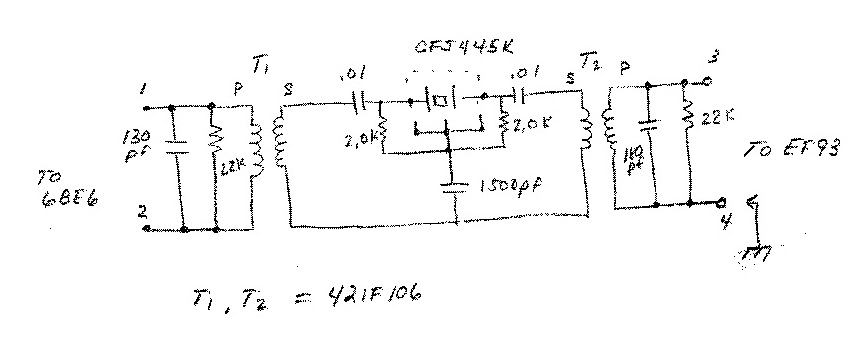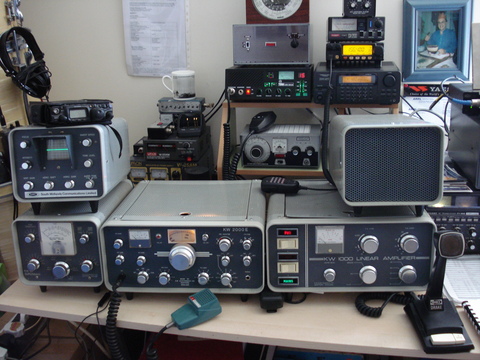
10-160 USB,LSB,CW
The entire KW station (Photo found on KW radio Yahoo Group)
The KW -2000 series of transceivers were very popular in the UK. They were first introduced in the 1960s. They were compact with both AC and DC power supplies available and they included 160 meters. Not many made it to the US. They suffered from VFO drift and also had 200KHz segmented bands much like Collins rigs of the time.
I acquired a KW-2000B transceiver several months ago. I normally don't buy a broke radio unless I have done some research into its faults and remedies. However, this radio with its beautiful front panel and bright aluminum knobs won me over and I forked out 100 green backs for the transceiver and matching AC power supply.
The rest of the story unfolds in the following pages.
The KW2000 transceiver was developed in response to the growing use
of single sideband on the amateur bands around 1960. To generate SSB
there are two basic circuit types. The phasing method and the filter
method. Suffice it to say that the phasing method requires more accurate
component values and is much harder to manufacture and keep tuned. The
filter method was selected for these radios based partly on the Collins
design. The KW-2000 employed a 455KHZ mechanical filter made by Kokusai.
The Kokusai MF-455-10CK filter was built in a small round can and the
mechanical flags were suspended in a spongy foam much like packing foam.
After 40 years this foam turned into a liquid goo. This caused the filter
elements to fall to the bottom of the can. There are several articles
on the web about repairing these filters but in my case the filter had
failed and was then shipped across the US. Needless to say the mechanical
filter was damaged beyond repair.
What to do now? I needed a replacement filter and I had three choices, find an original filter, replace the mechanical filter with a substitute or perhaps use a cheaper ceramic filter. The original filters have not been produced for 40 years or more and are not easy to come by. I gave up on finding an original filter very quickly. I did find a very nice Collins mechanical filter that would work for about 75 dollars, but I decided, (cheap as I am) to develop a ceramic filter assembly and try my luck at that.
There have been pervious attempts to replace the original filter with other types, notably the ceramic filters that Murata have produced. An article in Radcom for May1999 by Bruce Edwards G3WCE describes such a procedure. I decided to embark on this approach.
Here is a picture of the prototype Murata CFJ445K filter installation. The Filter is the same one used in many SSB CB and Single Band HAM 10 meter rigs. It is available for around 40 to 60 dollars regularly on ebay. Be very careful to purchase the correct filter. It must be one with a 2.4 KHz bandwidith. Anything wider will allow both sidebands to pass through from the balanced modulator. This will give you a DSB signal on both RX and TX. The transformers I used were obtained from Mouser Electronics and are 445 KHz 20K Ohm Primary and a 5K Ohm secondary miniature types. Part number 42IF106.
The schematic is shown below.
Opening the mechanical filter can was not that difficult. I used a large soldering iron (100 watt) but a small propane torch would have been faster. Heating up the bottom cup of the filter until the solder began to flow allowed the top section to be pulled off easily. Keep in mind, the assembly is too hot to handle without gloves.
Here is the schematic on my prototype filter. Since it worked so well, I have decided not to design a PCB but rather to stay with the "dead-bug" perfboard. Again "cheap" ...I mean frugal solutions have their appeal.

Here you can see the filter with the cover back on. The finished conversion?
This makes a neat package. Testing produced good results once the two transformers were peaked. This was done in both USB and LSB modes so as to balance the adjustments. I used a voltmeter to measure the signal at the control grid of the EF93 in transmit mode with the balanced modulator set out of balance.
After the filter was installed I found several other issues in the rig. All were caused by leaky or shorted capacitors. In this picture you can see one of the screen grid bypass caps has been replaced. These disc caps are known to be issues in the KW2000 series and it's a good idea to check them first when suspecting a fault. The VOX circuit also had a leaky cap that caused the VOX to energize after a few minutes of warm up.
In this picture you can see the faulty disc capacitors. The tan caps are all suspect. The red one is a replacement. Be sure to use a cap with the correct voltage rating. In this case the cap was leaky and reduced the screen voltage to a point where the tube was almost turned off.
The "sky hook" assembly style used in these radios was one I had never seen in a commercial product before. I would expect this in a homebrew project but not in a commercial rig. Take a look at this construction technique. It seems to work and does condense the size of the chassis needed.
In this photo you see the rig back in the case and ready for a QSO on 40 meters. I use this rig to check in to the Boat Anchor Net and always get great audio reports. So in summary my 100 dollar initial investment and an additional 70 dollars for a filter and two IF transformers turned out OK. I get a lot of questions about this rig. Few have actually seen one and even less have used one. All in all this is truly a boat anchor and is not worth much from a performance or reliability stand point, but if you want to have a rare bench warmer in the shack then this will make a fun addition to your collection. Here is a link to a Youtube video showing a KW2000B in use during the 2014 KWdays event in Englkand. http://www.youtube.com/watch?v=szQfz17ODd4.
The users group has moved to "Groups.io" , the new address is:-https://groups.io/g/KW-Radios. New members are welcome. They have a membership of over 500.
Serial Number B-1893
